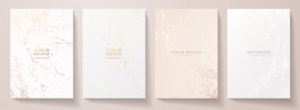Your product might be really beneficial to your clients. However, in a competitive market, this is insufficient to sell your goods to the customers. To attract clients, you must go above and beyond. While developing an efficient marketing strategy should be high on your priority list, you should not forget about your product label, which should be designed by a skilled graphic designer.
There are several reasons why a product label design is critical to your company’s long-term success. One of the most important things a great product label can do is make your items stand out from the competition.
Creating a distinct brand identity requires such differentiation of your product and organisation from the competition. Another reason to have a great label is that it can affect a customer’s purchasing choice.
On a shopping shelf, there are a lot of things lined up. If the design is appealing and original, the label will immediately capture potential clients’ attention to your goods. Customers who are indecisive about whether or not to buy your goods may be swayed by its distinctive label.
The way you show your goods within a store has a big impact on the success of your business.
So how can you design an attractive label? Here’s how-
Table Of Contents
1. Amplifying the Text
A product label often contains information such as the product’s name, the brand’s logo if the product is part of a company’s line, the number of units, and so on. It might also be a brief description or a tagline. On the other side of the label, you find comprehensive information- how to use, ingredients, etc.
Make sure the wording on your label design is readable. Allow your font to be large enough so that people can recognize it even from a distance. The font colour should contrast with the backdrop colour to improve readability even more. However, avoid using an out-of-the-box colour scheme. As a result, select a font colour that has both a high value and a low value.
Bright colour seems like a better option since it offers the customers a sense of confidence. Also, the color shades should be in sync with the brand’s existing visual style.
2. Keep an eye out for typographic pairings.
Because there is frequently minimal room for images and material on a product label, designers use typographic pairing to create visual contrast. With the aid of contrast, viewers may quickly detect the pieces of information. If there is a requirement for consistency across information, it is recommended that you utilise the same typeface. Typographic pairing’s major goal is to show the link between the information and various type selections. Use typefaces that represent the essence of the product to make the aesthetic more striking.
3. Realise the importance of white spaces.
The sections of a design that have not been used by the designer for photos, text, or other representations are known as white space. In other words, it is the design’s backdrop colour. A product label template becomes a savior when it comes to incorporating white spaces during the label making process. To make this process easier label and artwork management software will help you.
White space aids in the separation of chunks of various information, making it easier for clients to understand the specifics. It’s also utilised to distinguish things visually. Optimal utilization of white spaces ensures the simplicity of the design. This provides the design with a more refined appearance. It symbolises the product’s serenity. This is why white space is so important when designing a label for baby goods, cosmetics, and other similar items.
A strong product label with clear text and a basic logo design can help entice the audience. It displays the product’s user-friendliness and conveys a sense of simplicity.
4. Creative art on the label. Because, why not?
Illustration and graphic design components are required on some product labels. It’s employed when you need to give a better visual presentation of a product. You may make it apparent with the aid of an internet packaging design service provider.
5. Retain your uniqueness. You need to stand out, right?
Make sure your label design is one-of-a-kind, memorable, and distinctive.l Examine the labels of your rivals. Create an eye-catching design. You do not want to indulge in legal drama for a copied design. This might also take you to a vital factor, which can be deceiving to first-time clients.
Put nothing on the design that isn’t linked to the product only to make it appear better. To stimulate engagement with buyers, provide the company’s contact information efficiently. Integrity is essential!
6. Size of the label matters!
For product packaging, the design strongly relies on the size of your product label. When several labels are necessary, the front face usually just carries the emblem and the brand name. The rest of the data is buried at the back of the book.
Many designers, on the other hand, think that using a single “wrap-around” label is more cost-effective. It also contributes to the development of a brand identity by providing a more appealing design panel.
7. Quality is a determinant
The final but certainly not least aspect to think about is getting a nice print of the label. To make a positive first impression, try to increase the product’s visual presence using high-quality cards. So, whether you want a sleek sheen, a matte surface, or anything coated, get a professional to do it for you.
When it comes to making a distinctive product label, keep these pointers in mind. Collaboration is essential for any process and a label is definitely the highlight of your product. This is how Artwork Flow helps you in creating a seamless, interactive platform with your collaborators. Increase your productivity, and decrease your work hours! Time is money and it is your time to sign up and enjoy a relaxing label-making process.
